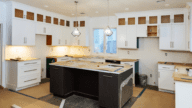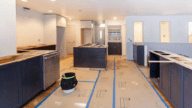Looking to Improve Home Value? Avoid These Projects With Terrible ROI
- Published on
- 13 min read
-
 Christine Bartsch, Contributing AuthorClose
Christine Bartsch, Contributing AuthorClose Christine Bartsch Contributing Author
Christine Bartsch Contributing AuthorFormer art and design instructor Christine Bartsch holds an MFA in creative writing from Spalding University. Launching her writing career in 2007, Christine has crafted interior design content for companies including USA Today and Houzz.
-
 Sam Dadofalza, Associate EditorClose
Sam Dadofalza, Associate EditorClose Sam Dadofalza Associate Editor
Sam Dadofalza Associate EditorSam Dadofalza is an associate editor at HomeLight, where she crafts insightful stories to guide homebuyers and sellers through the intricacies of real estate transactions. She has previously contributed to digital marketing firms and online business publications, honing her skills in creating engaging and informative content.
Celebrities who perform dramatic home makeovers on TV and the average homeowner on Main Street live in two very different worlds. One has the budget of a reality show to foot the bill for materials and labor, and the other has whatever’s in their bank account and tight profit margins. To successfully improve home value, it’s essential to identify which projects are truly worth the effort and investment.
So halt your plans for a $50,000 chef’s kitchen and luxurious master suite inspired by Fixer Upper until you know all the facts. When the purpose of your project is to improve home value and boost the asking price at resale, it’s smart to spend less on several smaller cosmetic improvements rather than one or two major room overhauls.
More importantly, you need to remove your personal bias from design decisions or risk turning off buyers from your custom taste.
“When a seller updates the home based on personal preferences, there’s probably a 70% or 80% chance you’re going to make the wrong decisions,” advises Cleve Gaddis, a top-selling agent in Johns Creek, Georgia.
“A professional agent has a complete understanding of what current buyer preferences are, so they can tell you where to spend money to appeal to the largest number of buyers.”
Let’s take a look at some of the most popular pricey projects that have the lowest return on investment (ROI) and the wiser, low-cost upgrades that offer a bigger bang for your buck.
Start with what HomeLight’s data says about top home features
Our Top Agent Insights for End of Year 2024 report surveyed over 750 leading real estate agents nationwide, uncovering the features that have become the hottest selling points in today’s market. Here’s what buyers are seeking, as agents noted:
- Updated kitchens and appliances: 88%
- Enhanced curb appeal, outdoor, and garden spaces: 48%
- Home offices or remote work areas: 38%
- Luxurious primary bathrooms: 36%
- Energy-efficient features: 9%
Real estate agents estimate that certain updates can significantly boost a home’s value. For example, a kitchen remodel can add an average of $28,826 to the value of a median-priced home. Even smaller updates yield remarkable returns: a fresh coat of paint could increase your home’s value by $10,184, and thorough decluttering could net an additional $11,706.
However, while these features are undeniably appealing to buyers, not every improvement guarantees a high ROI. For instance, embarking on a full-scale kitchen or bathroom overhaul may not always be the wisest financial decision.
These projects are not only extremely costly but there’s also the risk that your design choices may not align with the tastes and preferences of potential homebuyers.
Instead, consider which projects will balance buyer appeal with profitability. Simple upgrades like painting, landscaping, and minor renovations often deliver the highest ROI without breaking the bank.
The key to adding value lies in strategically investing in the right projects, those that resonate with buyers and pay off in the end.
Using our own data and other credible sources, such as The Journal of Light Construction (JLC) and top real estate agents in the HomeLight network, we put together this list of basic do’s and don’ts when it comes to home renovations.
1. DON’T: Drop big bucks on a full kitchen renovation
If you’re in a house built more than a decade ago that’s never been remodeled, you’re living with an outdated kitchen. And if you’ve spent any time cooking in it, chances are you’ve imagined ripping it out more than once.
Prepping to sell the place may seem like the perfect time to invest in finally making that dream kitchen come true, but it may shock you how much that dream will cost.
According to JLC, a major kitchen remodeling project costs $79,982, but would only recoup 49.5% of the cost. And if you make that major kitchen renovation without consulting an agent, you’ll likely spend more money than necessary on the wrong design choices.
“One of my clients chose all of her own upgrades, and the combination of the countertop with the backsplash couldn’t have been worse if she had intended to pick the worst,” recalls Gaddis.
“It took an extra three months to sell the home, we wound up having to change out the backsplash, and she spent twice as much on the upgrades as she should’ve in the first place.”

2. DO: Give the kitchen a less than $5,000 makeover
The truth is, Gaddis’ client could have achieved the look of a fully remodeled kitchen by spending just a few thousand dollars on the right items.
“If you’re improving the kitchen, you’ll never get your money back by changing out the cabinets,” advises Gaddis. “Instead, just do cosmetic fixes like painting the existing cabinets, changing out the cabinet hardware, and replacing the countertops with granite.”
Replacing the countertop, perhaps already the most expensive part of this minor kitchen makeover, costs an average of $3,155 only. The final cost depends on the material, edging, and backsplash options you choose.
Install those countertops and repaint the cabinets for as little as $425 to $1,460. Then invest as little as $500 in replacing the sink, faucet, and cabinet hardware. The kitchen will look like a full remodel for less than $5,000.
According to JLC, a minor, midrange kitchen remodel can cost up to $27,492, and you’ll be able to recoup 96.1% of your costs.
3. DON’T: Completely renovate the bathroom
As arguably the grungiest room in the house, completely remodeling the bathroom makes sense. At an average cost of $12,000, it’s cheaper than redoing the kitchen.
Unfortunately, while it’s technically cheaper, the ROI for a bathroom model is worse. A remodeling project with a universal design only recoups 49.4% of the costs.
4. DO: Replace outdated fixtures
Want to know what shows the age of your bathroom the most? It’s the fixtures—both faucets and lighting. Luckily, you can achieve a “brand-new bathroom” look by swapping them out without spending a whole lot.
“In the bathrooms, it’s all about the mirrors and the fixtures,” explains Gaddis. “Light and faucet fixtures just need to be current. And if you have old mirrors, you can add a framed border, or install smaller mirrors over his and hers sinks.”
On the surface, replacing fixtures sounds pricey, at $350 per faucet — but remember that the big chunk of that is labor costs. You can make the most of that labor cost by having all plumbing fixtures at once, including all shower, tub, and sink faucets in both the kitchen and bathrooms.
The same is true of replacing outdated light fixtures in the bathroom. Instead of paying an electrician around $500 to install one light fixture, negotiate a deal to replace lighting throughout the house.
Keep costs low by purchasing mid-range-priced faucets and light fixtures in advance—with advice on style and finishes from your real estate agent. Then, place each one in the room where you want it installed to ensure each fixture gets put in the right place.
You can save even more if you DIY these projects—but only if you can guarantee a professional-grade finished look. The last thing you want is to pay for a fixture twice because your DIY attempts resulted in fixtures installed sloppily or incorrectly.
Keep in mind that DIY installations aren’t as easy in the bathroom because of cramped quarters and hard-to-reach nooks and crannies.
For example, maybe your successful installation of new tile flooring in the squared-off floorspace of a bedroom has your confidence up. Unfortunately, in the bathroom, you’ll need to make finicky cuts (and countless recuts) to fit square tiles in awkward angles around the sink, toilet, and tub.
5. DON’T: Finish the basement
“The bigger the house, the higher the price.” This sounds right, but it’s only true in the broadest terms.
Each additional 1,000 square feet of living space increases the selling price by around 30%. However, where you add that extra square footage matters.
Unless you’re adding a ground-floor bonus room (which can also have a negative impact by shrinking your yard space), you’re not going to see that high of a return simply by finishing your basement into additional living space.
“Some clients think they can finish the basement area in a home and make a good return,” says Gaddis. “The fact is, basement square footage in the Metro Atlanta area is probably only worth about one-third per square foot compared to the rest of the house. So you’ll never get your money back.”
On average, you’ll spend around $32,000 finishing the basement and getting it up to code to be counted as additional living space. However, you’ll only get 64% ROI.
And that’s if you don’t run into any trouble. Finishing a basement isn’t as simple as remodeling an above-ground room.
For starters, you’ll need specialty drywall that can withstand damp, mold-prone basement conditions. Then there’s all the work required to build accessible facades to hide your home’s systems, such as the water heater, furnace, plumbing, or laundry room.
In other words, the extra work and expense it takes to make a basement livable simply isn’t worth the investment if all you want to do is increase your home’s value.
6. DO: Repaint and replace carpeting in existing living spaces
Rather than pouring money into adding a few extra square feet of living space, it’s smarter to make the existing living spaces more inviting and livable—with fresh paint and new flooring.
Fresh paint is kind of like the “new car” smell for houses, which is why most agents advise clients to get the home interior repainted, even if that’s the only upgrade they can afford to make.
The national average for having the whole home interior painted is $3,178, but you can probably get your home painted for less than that.
A lot of figures factor into painting costs: the square footage, the brand of paint you use, the colors you choose for the rooms and walls, and whether or not you paint the baseboards and trim a second color. The choices are endless.
Who you choose to do the job also makes a difference. Unless you have the time and talent to go DIY, it’s smarter to pay a professional to do the job right—and faster, too.
The situation is the same when it comes to flooring. Installing new wood flooring offers a 118% ROI, while refinishing existing hardwood floors provides a 147% ROI.
This is a modest estimate when you consider how turned off buyers can get by old, stained, heavily trafficked carpeting. While there’s no guarantee that you’ll make money on your home by installing new flooring, you won’t lose money on that investment.
And most agents will tell you that new interior paint and flooring will go a long way toward selling your home faster—which will save you money in the long run.
If you do decide to go with a pro to replace the floors and the walls, make sure to check with your agent first.
Not only can they help you pick the colors and materials, they’ll likely have connections to painters and flooring experts who’ll cut you a deal based on their referral.
7. DON’T: Install a new HVAC (unless it’s 100% broken)
Is your HVAC old, less-than-efficient, and potentially on its last legs? Even if all of that’s true, that doesn’t mean you should spend $3,500 – $7,500 to replace it before selling the house.
“Home sellers have to be very careful upgrading the systems, like the HVAC. It needs to be in good repair, but it doesn’t need to be new,” advises Gaddis.
“Expensive upgrades that buyers can’t see and get excited about won’t add nearly as much value as cosmetic improvements. If you spend up to $8,000 on replacing it, you’ll have a very hard time getting your money back. Buyers won’t pay an extra $10,000 for an HVAC, but they’ll pay $20,000 more for a nice kitchen all day long.”
The only time you need to completely replace the HVAC is if it’s totally broken and can’t be repaired. Even then, the buyer may be able to work the replacement cost into the home sale so they can buy the HVAC they want.
8. DO: Replace the thermostat
The smarter play is to simply pay $100 to $650 for HVAC servicing so a qualified technician can get your existing sytem into the best possible shape.
Quite frankly, most buyers aren’t thinking about the age of your home’s inner workings—unless they’re not working. The only thing that’ll get them wondering about your HVAC’s condition is an outdated, mechanical thermostat.
The truth is, you can actually install a new digital thermostat to control your old HVAC. Even the fanciest smart thermostats, which can be controlled via phone apps, can work on most HVACs.
So for the low cost of $20 to $300 (depending on the thermostat you choose), you’ve got the bells-and-whistles look of a state-of-the-art HVAC that’ll appeal to tech-savvy buyers—without the big expense of replacing the whole unit.
And if you have that smart thermostat ready to install when you get your HVAC serviced, the technician may be willing to install it for you for a small additional fee, or even for free.
Spend less on renovations to make more money back
The cost of selling a house (plus moving expenses) is enough strain on your wallet — there’s no need to spend big bucks on one major renovation when a handful of minor upgrades throughout the home will actually net you a bigger ROI.
“A good agent will not let a seller spend $20,000 to get $20,000 back, because that doesn’t make any sense. You’re better off just selling the house as-is,” says Gaddis.
“The best agents work to help clients get two to three dollars back for every dollar spent. And those agents won’t be guessing. When you sell a lot of houses, you get pretty good at the science behind ROI.”
So, when you’re prepping your home for sale, consult with your real estate agent before spending a penny on home improvements.
Article Image Source: (Annie Spratt/ Unsplash)




